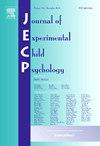描绘数学家:研究性别和数学焦虑如何与小学晚期和中学学生对数学家的表征相关
IF 2
2区 心理学
Q3 PSYCHOLOGY, DEVELOPMENTAL
引用次数: 0
摘要
一种常见的性别刻板印象是,男性在数学方面比女性表现得更好。这种刻板印象不仅影响学生的数学成绩,还影响他们在科学、技术、工程和数学(STEM)领域的兴趣和职业选择。“画一个数学家任务”(DAMT)被用来了解学生对谁是数学家的看法。然而,现有的DAMT研究往往没有考虑与性别刻板印象密切相关的其他个体特征的作用,比如数学焦虑。目前的研究调查了学生的数学焦虑、性别和年级水平如何与他们对数学家的性别表征和他们的绘画中包含的数学难度水平相关。学生(N = 261;133名女生,128名男生;116名四年级学生,89名六年级学生,56名八年级学生完成了一份数学焦虑问卷,然后被要求画一幅数学家的画,并解释他们的想法来自哪里。总体而言,女生吸引的女数学家比男生多,而吸引女数学家的学生比例在八年级时急剧下降,尤其是女生。女孩比男孩表现出更高的数学焦虑水平,而且数学焦虑在各个年级都有所增加。然而,数学焦虑与学生绘画的内容无关。这项研究强调了努力支持女孩在数学方面的归属感的重要性,特别是在中学阶段,因为据报道,中学阶段的数学焦虑水平较高。本文章由计算机程序翻译,如有差异,请以英文原文为准。
Picturing mathematicians: Examining how gender and math anxiety relate to students’ representations of mathematicians in late elementary and middle school
A common gender stereotype is that men are higher performers than women in math. This stereotype not only affects students’ math performance but also influences their interests and vocational options in science, technology, engineering, and mathematics (STEM). The “Draw-a-Mathematician Task” (DAMT) has been used to understand students’ perceptions of who is a mathematician. However, the existing studies with DAMT often do not consider the role of other individual traits that are closely associated with gender stereotypes, such as math anxiety. The current study examined how students’ math anxiety, gender, and grade level may be associated with their gendered representations of mathematicians and the level of math difficulty included in their drawings. Students (N = 261; 133 girls, 128 boys; 116 fourth graders, 89 sixth graders, 56 eighth graders) completed a math anxiety questionnaire and were then asked to draw a picture of a mathematician and explain where their ideas came from. Overall, girls drew more female mathematicians than boys, and the proportion of students drawing female mathematicians dropped steeply in eighth grade, particularly for girls. Girls showed higher levels of math anxiety than boys, and math anxiety increased across grades. However, math anxiety was unrelated to the content of students’ drawings. This study emphasizes the importance of efforts to support girls’ sense of belonging in mathematics, especially into secondary grades in which reported levels of math anxiety are higher.
求助全文
通过发布文献求助,成功后即可免费获取论文全文。
去求助
来源期刊

Journal of Experimental Child Psychology
Multiple-
CiteScore
4.50
自引率
7.70%
发文量
190
期刊介绍:
The Journal of Experimental Child Psychology is an excellent source of information concerning all aspects of the development of children. It includes empirical psychological research on cognitive, social/emotional, and physical development. In addition, the journal periodically publishes Special Topic issues.
 求助内容:
求助内容: 应助结果提醒方式:
应助结果提醒方式:


